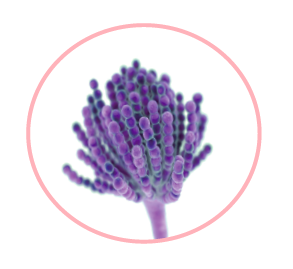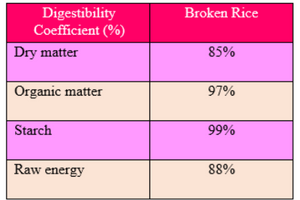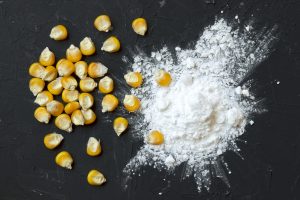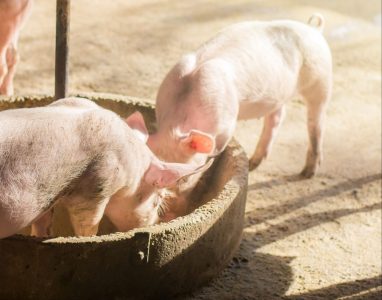 18 Mar 2022
18 Mar 2022
Rice by-products: their use in the feeding of weaning piglets
Pig feed accounts for approximately 60% of production costs. Therefore, some studies have been carried out with new ingredients to determine their nutritional value, biological response and the economic viability of their inclusion in diets.
Agribusiness co-products have potential for use in animal feed.
 The use of rice by-products deserves attention as it is a staple cereal for human consumption which is grown in most tropical and semi-tropical regions.
The use of rice by-products deserves attention as it is a staple cereal for human consumption which is grown in most tropical and semi-tropical regions.
Of the total rice production, about 70% is used for human consumption while waste from the milling industry, including rice husks, rice bran, and broken rice, can be used in animal feed.
Broken rice (BR) is obtained during the sieving process. It consists of broken and malformed grains which correspond to 14% of the total grain. Broken rice has been used as a great alternative to corn in animal feed due to its similar metabolizable energy and crude protein values.(Nepomuceno et al, 2011; Che et al., 2012).
However, BR has a lower fat content and a higher starch percentage than corn (Rostagno et al., 2017) and contains a very low concentration of fiber (Che et al. , 2012).
 Some advantages of replacing corn with rice co-products relate to the low levels of mycotoxins in the grain. Due to the fact that corn tends to be affected with high contamination, predominantly with aflatoxins.
Some advantages of replacing corn with rice co-products relate to the low levels of mycotoxins in the grain. Due to the fact that corn tends to be affected with high contamination, predominantly with aflatoxins.
Rice and corn co-products have shown similar effects on animal yield, but rice may induce prebiotic effects and increase serum IgA concentrations, indicating a better immune response (Henderson et al., 2012).

[register]Plasma TNF-α concentrations observed in pig-fed diets with increasing concentrations of rice bran indicate a potential power to reduce inflammatory responses in the gut (Casas and Stein, 2016).
The inclusion of 10% rice bran improved feed efficiency and increased the concentration of colonic bifidobacteria in weaned piglets, indicating that this by-product may also have prebiotic properties (Herfel et al., 2013).
Table 1 presents the nutritional composition of broken rice. In relation to the total carbohydrate content. The values were 896 gr/kg, of which 890 g/kg were non-fibrous carbohydrates, indicating that rice grains are characterized by a high starch content and a low amount of non-starchy polysaccharides.
Table1. Nutritional composition of broken rice (rice by-product)

Modified from Carvalho et al., 2018
According to different studies where the nutritional compostion of broken rice has been described, these co-products can present great variability depending on:

This raises the need for studies to determine the product’s nutritional value when supplied to animals.
Raw energy in food is provided by the combustion process of its ingredients. However, some molecules produce more heat (ether extract and starch) than others (crude protein and fibrous carbohydrates).
Considering the digestibility coefficients and digestible nutrients (Table 2), it can be inferred that these rice by-products are a good energy source for pigs (from 15 to 30kg body weight). It was shown that there is a high ratio of ME:DE (Metabolizable Energy: Digestible Energy) due to the high metabolism of components found in rice co-products. This translates into a low urine excretion rate.
Table 2. Apparent digestibility coefficient of broken rice components.

Modified from Carvalho et al. (2018)
Menoyo et al. (2011) also observed high Digestibility Coefficient values for organic matter (86%), starch (90%) and gross energy (84%) of rice bran in piglets. In addition, the authors found that starch digestibility was better for rice bran than for corn.

The higher digestibility values for rice by-products can be explained by the different starch content of grains. Greater availability of starch in the grain of rice compared to that of corn, in addition to the smaller grain size of rice, allows greater digestive enzyme activity. (Svihus et al., 2005).
Rice is characterized by high starch content and low fiber content. Therefore, it can have a major impact on the digestibility of dietary nutrients (Che et al., 2012).
Starch is an excellent source of energy. Due to the fact that rice co-products contain lower levels of soluble non-starchy polysaccharides, this decreases digestion viscosity resulting in a lower incidence of diarrhea and reduced proliferation of potentially harmful bacteria.

![]() When replacing corn with rice (0, 500, 750 and 1000 g/kg of BP) in piglet feed (0 to 42 days post-weaning), Che et al. (2012) found no difference in animal performance. In a similar way, Menoyo et al. (2011),observed no differences in yield variables when evaluating the use of Crude (BR) and thermally processed (BR) compared to that of corn in weaned piglets.
When replacing corn with rice (0, 500, 750 and 1000 g/kg of BP) in piglet feed (0 to 42 days post-weaning), Che et al. (2012) found no difference in animal performance. In a similar way, Menoyo et al. (2011),observed no differences in yield variables when evaluating the use of Crude (BR) and thermally processed (BR) compared to that of corn in weaned piglets.
Conclusions
Previous studies indicate that rice bran can improve the animal’s health status and contribute to positive growth performance results.
Source: Carvalho et al., 2018. August 2018 SEMINA: AGRICULTURAL SCIENCES 39(4):1695 DOI: 10.5433/1679-0359.2018v39n4p1695
[/register]
Subscribe now to the technical magazine of animal nutrition
AUTHORS

Nutritional Interventions to Improve Fertility in Male Broiler Breeders
Edgar Oviedo
The Use of Organic Acids in Poultry: A Natural Path to Health and Productivity
M. Naeem
Synergistic Benefits of Prebiotics and Probiotics in Poultry, Swine, and Cattle
Gustavo Adolfo Quintana-Ospina
Hybrid Rye Potential in Laying Hen Feed Rations
Gwendolyn Jones
A day in the life of phosphorus in pigs: Part I
Rafael Duran Giménez-Rico
Use of enzymes in diets for ruminants
Braulio de la Calle Campos
Minerals and Hoof Health in the Pregnant Sow
Juan Gabriel Espino
Impact of Oxidized Fats on Swine Reproduction and Offspring
Maria Alejandra Perez Alvarado